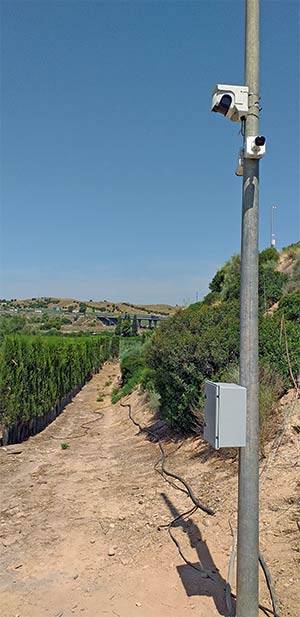Effectively monitoring perimeters requires security technologies to locate intrusions quickly and accurately. This can be particularly challenging for certain technologies as perimeters are exposed to external changing conditions.
“One of the main issues faced by security systems relying on AI and cameras with analytics is the number of nuisance alarms. Sensing technologies can efficiently solve this problem and are successfully deployed in many sites to improve the efficiency of surveillance and security system”, states Mark Cosgrave.
Challenging environment

Environmental factors such as rain, snow or extreme temperatures can indeed have a significant impact on the performance and reliability of some security technologies.
”Cameras can be affected by light conditions and can struggle to classify objects in spaces where the field of view is narrow – for instance outdoor corridors and areas with occlusions. Foliage and wildlife can also be triggers of false alerts.”
Nuisance alarms
As a solution to minimise nuisance alarms in certain areas of the perimeter, security teams may consider excluding entire zones, which then leads to the problem of keeping wide areas unsecured and vulnerable to intrusion, which troubles Mark Cosgrave.
”Excessive false alarms become costly as it requires more resources to verify activations, but also requires installers to keep coming back for tweaking the system, which is unfortunately inefficient and frustrating. Systems with excessive false alarms become unreliable which means surveillance personnel are not confident on the solution, and this can lead to an even worst outcome: failing to react to real intrusions,” he says.
A reliable system
Mark Cosgrave claims that the performance of the security system should not be compromised by lighting, weather or other outdoor conditions. He emphasises that sensing technologies have been specifically designed to ‘detect’ and are not affected by light, variable temperature or external factors such as wind, rain or snow.”
In addition, sensors can learn and adapt to the environment, enabling them to filter out common causes of nuisance alarms.
”For instance, continuously adjusting the detection area to take into consideration changes happening on ground such as accumulation of snow or leaves. Some of the most advanced sensors can also be equipped with environmental resistance functions to reduce false alarms due to harsh environments like fog or snow,” states Mark Cosgrave.

Brings intelligence
Sensing technologies can make a big difference to quickly and accurately detect an intrusion and pinpoint its location, according to Mark Cosgrave.
”With a wide array of active and passive sensing technologies available in the market, customers have a choice of solutions to adapt to their security needs and help them achieve an intelligent security system. Alerts can be set to be triggered based on certain events happening, certain areas been accessed or based on a specified target size or height,” he says and adds:
“With sensors, the detection performance is not to be affected by the distance and sensors should be able to reliably detect at any point within their field of detection and without losing perspective. Lastly sensing technologies will be able to adapt to the required detection area, whether this is a very narrow corridor or an open area.”
Advantages of sensors
One of the goals of perimeter security is to enable a system that can anticipate potential threats and take actions appropriately. An advantage of sensing technologies is they are actively looking out for any suspicious activity and have the intelligence to identify situations that require immediate attention.
“More importantly, sensors will rapidly initiate a pre-determined security response, whether it is triggering lights, activating audio alerts, guiding security cameras or alerting security guards, contributing to an automated system,” comments Mark Cosgrave.
Efficient security
When designing a perimeter security system the first stop should be identifying what are the goals, which are the key areas in the perimeter and stablish what is the level of security required.
“Different security technologies serve different purposes and relying on sensing technologies for detection can bring intelligence to the security system, minimize nuisance alarms and contribute to more efficient and powerful security, he says in conclusion.

















